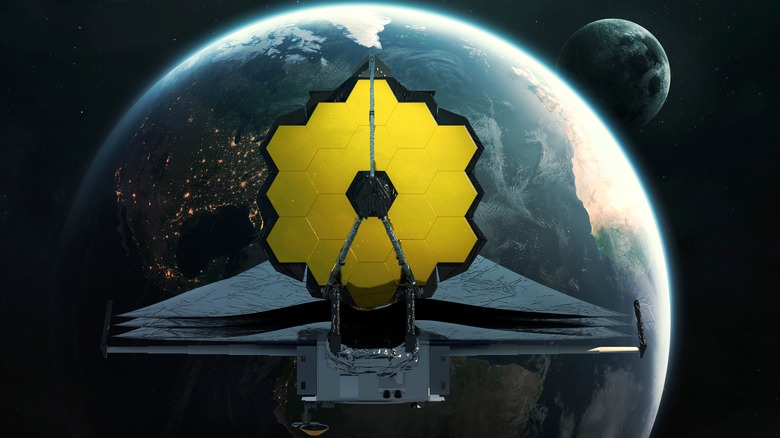The James Webb Telescope's Mirrors Are Now Aligned - Why That's Important
NASA has announced that it hit a massive milestone in getting the James Webb Space Telescope ready for science operations this summer. The telescope's mirrors are now fully aligned, and the engineering team is confident that the telescope will meet or even exceed its science goals (via NASA). It has been a complicated process to get the mirrors into alignment; the telescope's primary mirror is made up of 18 separate hexagon-shaped segments which fit together to create a 6.5 meter-wide mirror. The use of separate segments meant that the mirror could be folded up, origami style, so that they could fit into the rocket which carried the telescope into space. Once the telescope was deployed, the segments were folded into place to create a mirror larger than would have been possible as a single piece.
A large mirror is important as it allows a telescope to be more sensitive and that sensitivity is vital when you are looking at very distant, very faint objects like the James Webb will be doing. As the world's most powerful space telescope, it will be able to observe some of the most distant galaxies; because light takes time to travel, looking at these very distant galaxies is like looking back in time to when the universe was very young, allowing us to learn about how the universe evolved after the Big Bang. "More than 20 years ago, the Webb team set out to build the most powerful telescope that anyone has ever put in space and came up with an audacious optical design to meet demanding science goals," said Thomas Zurbuchen, associate administrator for NASA's Science Mission Directorate in Washington. "Today we can say that design is going to deliver."
The James Webb Telescope's final phases of alignment
To get the James Webb Telescope's 18 segments to work as one, large mirror required nanometer precision. The final phase in the mirror alignment process is called fine phasing, when final checks are made on the alignment of the mirrors over three tests, using parts of the science instruments to add a slight defocus to the mirror for checking purposes (via NASA). With this phase complete, the Webb team confirmed that there were no critical issues with the mirror and that all of the parameters they were testing were within the margins they wanted (via NASA).
Now the mirror is aligned to Webb's main camera, called the Near-Infrared Camera, and the team can begin aligning the telescope's three other instruments as well: the Near-Infrared Spectrograph, the Mid-Infrared Instrument, and the Near Infrared Imager and Slitless Spectrograph. The successful alignment bodes well for future science being planned for the telescope. "We have fully aligned and focused the telescope on a star, and the performance is beating specifications. We are excited about what this means for science," said Ritva Keski-Kuha, deputy optical telescope element manager for Webb at NASA Goddard. "We now know we have built the right telescope."
